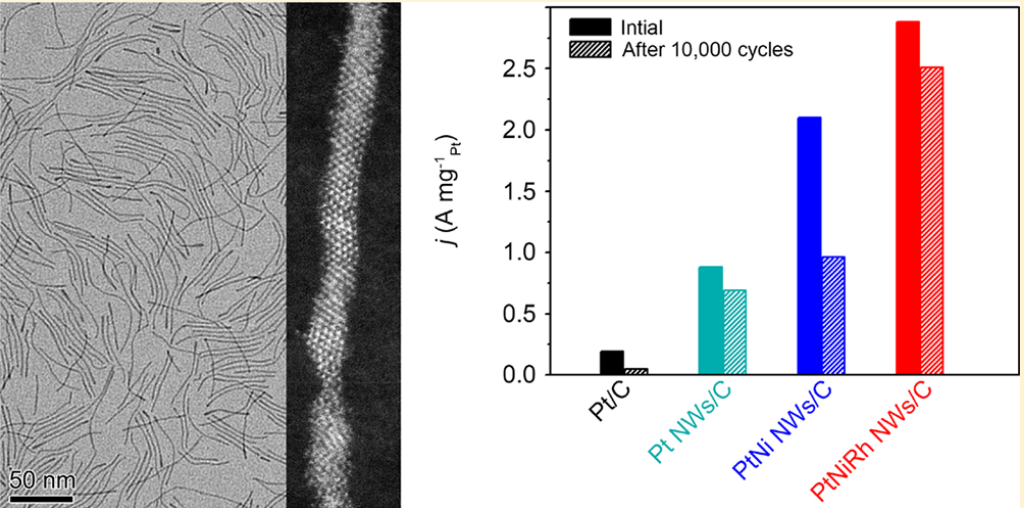In the quest for promising alternatives to conventional fossil fuel, scientists have invested a great deal of effort in developing fuel cell technology. Oxygen reduction reaction (ORR), a cathodic reaction of fuel cells, is one of the most extensively studied topics in the field. The research group of Prof. ZENG Jie from Hefei National Laboratory for Physical Sciences at the Microscale & School of Chemistry and Materials Science, in collaboration with Prof. HUANG Hongwen from Hunan University, has made significant progress in designing novel nanocatalysts toward high-efficient oxygen reduction reaction (ORR).

Structure of PtNiRh Trimetallic Nanowires and their catalytic performance in oxygen reduction reaction. (Image by LI Kan)
As a member of the fuel cell family, proton exchange membrane fuel cells (PEMFCs) have been recognized as a promising clean energy conversion technology for efficient power delivery in transportation and mobile devices. However, the commercialization of such technology has so far been hampered by the prohibitive cost of associated devices, because a large amount of precious platinum (Pt) catalyst is required in order to mitigate the sluggish kinetics of the oxygen reduction reaction (ORR). To reduce the usage of Pt catalyst in PEMFCs, one solution is to improve the mass activity of a catalyst. Although a number of Pt-based catalysts with excellent mass activities have been reported, most of them still suffer from mediocre durability due to their thermodynamically unstable structures that are generally needed for high mass activity. The conflict between high mass activity and superior durability seems to be an intricate problem to solve.
Faced with the challenges, researchers designed and synthesized a remarkable Pt-based catalyst by combining the high utilization efficiency of Pt atoms and the long-term durability of anisotropic one-dimensional metals-doped Pt nanowires. The mass activity and specific activity of the produced Pt-Ni-Rh Trimetallic Nanowires are 15.2 and 9.7 times higher than that of commercial carbon-supported platinum catalyst (Pt/C), respectively. Moreover, even after 10,000 cycles of accelerated durability test in oxygen condition, the doped Pt nanowires/C catalyst exhibits a drop of 12.8 % in mass activity, against a big decrease of 73.7% for commercial Pt/C.
The research was published on the Journal of the American Chemical Society with the title of One-Nanometer-Thick PtNiRh Trimetallic Nanowires with Enhanced Oxygen Reduction Electrocatalysis in Acid Media: Integrating Multiple Advantages into One Catalyst. Graduate student LI Kanand Dr. LI Xingxing contributed equally to this work.
This work was supported by CAS, MOST of China, National Natural Science Foundation of China, and China Postdoctoral Science Foundation.
(Provided by Hefei National Laboratory for Physical Sciences at the Microscale and School of Chemistry and Materials Science. Edited by WU Qiran, USTC News Center)